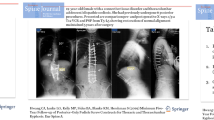Summary
The authors describe a series of 28 patients with thoracolumbar spine injury who were decompressed via a posterolateral approach and stabilized with a new material for osteosynthesis called Diapason. Similarly to other osteosynthesis systems, it combines the advantages of pedicular fixation and rod stabilization.
All patients were studied pre- and postoperative by plain X-ray films, standard and 3-D CT scan. The sagittal index (S.I.) was calculated in all patients to quantify segmental sagittal deformity. Patient follow-up ranged from 1 to 3 years.
Twenty-two patients who presented with neurological deficit improved (78.5%). Twenty-six patients (92.8%) developed osseous union and 5 patients with spinal deformity (S.I. > 15 °) presented a postoperative S.I. of less than 5 ° at long-term check-up; S.I. underwent a current of 2 ° in one patient only but it remained stable at subsequent controls. Instrument failure occurred in 4 cases (screw breakage in 1 case, rod displacement in 3) but only one required reoperation because the others were asymptomatic and presented solid fusions.
Similar content being viewed by others
References
An HS, Cotler JM (eds) (1992) Spinal instrumentation. William and Wilkins, Baltimore
Argenson C, Boileau P (1993) Classification of thoracolumbar spine fractures. In: Floman Y, Farcy JP, Argenson C (eds) Thoracolumbar spine fractures. Raven, New York, pp 131–156
Argenson C (1993) Orthopaedic principles of surgical management. In: Floman Y, Farcy JP, Argenson C (eds) Thoracolumbar spine fractures. Raven, New York, pp 179–194
Argenson C, Boileau P (1993) Specific injuries and management. In: Floman Y, Farcy JP, Argenson C (eds) Thoracolumbar spine fractures. Raven, New York, pp 195–214
Denis F (1983) The three column spine and its significance in the classification of acute thoracolumbar spinal injuries. Spine 8: 817–831
Dickman CA, Fessler RG, MacMillan M, Haid RW (1992) Transpedicular screw-rod fixation of the lumbar spine: operative technique and outcome in 104 cases. J Neurosurg 77: 860–870
Farcy JP, Weidenbaum M, Glassman SD (1990) Sagittal index in management of thoracolumbar burst fractures. Spine 15: 958–965
Frankel H, Hancock Det al (1969) The value of postural reduction in the initial management of closed injuries of the spine with paraplegia and tetraplegia. Part I. Paraplegia 7: 179–192
Krag MH (1991) Biomechanics of thoracolumbar spinal fixation. A review. Spine 16 [Suppl 3] S84-S99
Krag MH, Beynnon BD, Pope MHet al (1986) An internal fixator for posterior application to short segments of the thoracic, lumbar or lumbosacral spine. Design and testing. Clin Orthop 203: 75–98
Magerl FP (1984) Stabilization of the lower thoracic and lumbar spine with external skeletal fixation. Clin Orthop 189: 125–141
Moreland DB, Egnatchik JG, Bennet GJ (1990) Cotrel-Dubousset instrumentation for the treatment of thoracolumbar fractures. Neurosurgery 27: 69–73
Richaud J, Boetto S, Lazorthes Y (1986) Posterolateral approach and anterior spinal canal recalibration in severe spinal injury affecting T12-L1: a study of seven cases. Neurosurgery 19: 218–227
Roy-Camille R, Saillant G, Mazel C (1986) Plating of thoracic, thoracolumbar and lumbar injuries with pedicle screw plates. Orthop Clin North Am 17: 147–159
Weidenbaum M, Farcy JP (1991) Surgical management of thoracic and lumbar burst fractures. In: Bridwell KH, DeWald (eds) Spinal surgery. Lippincott, Philadelphia, pp 911–957
West JL III, Bradford DS, Ogilvie JW (1991) Results of spinal arthrodesis with pedicle screw-plate fixation. J Bone Joint Surg (Am) 73: 1179–1184
West JL III, Ogilvie JW, Bradford DS (1991) Complications of the variable screw plate pedicle screw fixation. Spine 16: 576–579
Whitecloud TS II, Butler JC, Cohen JL,et al (1989) Complications with the variable spinal plating system. Spine 14: 472–476
Yoganandan N, Larson SJ, Pintar F,et al (1990) Biomechanics of lumbar pedicle screw/plate fixation in trauma. Neurosurgery 27: 873–881
Zindrick MR, Wiltse LL, Widell EH,et al (1986) A biomechanical study of intrapeduncular screw fixation in the lumbosacral spine. Clin Orthop 203: 99–112
Author information
Authors and Affiliations
Rights and permissions
About this article
Cite this article
Ciappetta, P., Delfini, R. & Costanzo, G. Posterolateral decompression and stabilization of thoracolumbar injuries using diapason instrumentation. Acta neurochir 138, 314–321 (1996). https://doi.org/10.1007/BF01411743
Issue Date:
DOI: https://doi.org/10.1007/BF01411743




